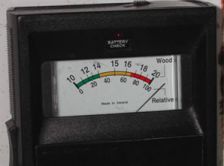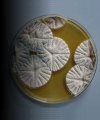Black Toxic Mold Inspection and Testing
Black Toxic Mold Inspection
If you think you might have black toxic mold in your home but cannot find it you should have a mold inspection performed.The goal of a black toxic mold inspection is to find the black toxic mold colony and also to find and fix the moisture problem which caused the mold.
After the mold inspection you should have mold testing to identify whether the mold is black toxic mold. Mold testing can also help to find any mold the inspection might have missed.
Professional Black Toxic Mold Inspection and Testing

Moisture Meter
Black toxic mold usually grows hidden behind walls, above the ceiling or below the floor. Professional black toxic mold inspectors use tools such as a hygrometer to measure humidity, fiber optics to look into wall cavities and moisture meters to find potential areas for black toxic mold growth.
The Black Toxic Mold Inspection Process
All rooms of the house including the attic and basement should be thoroughly checked for signs of black toxic mold. Black toxic mold can emit a musty smell so the mold inspector should take notice of any odors also.Special attention should be paid to areas with water sources such as near pipes, sinks and the shower. The mold inspector needs to also know about any spots that have had a history of water damage, eg from leaks or flooding.
Signs of water damage to look out for are abnormal surfaces, eg warped walls or cracked paint. Small dark mold spots on walls or other surfaces can indicate black toxic mold is growing on the other side.
Careful attention should be given where there are materials high in cellulose such as drywall, ceiling tiles, cardboard or paper. Black toxic mold often grows in other hidden places like ventilation systems or under carpet. These spots should also be examined carefully.
If the mold inspection finds mold growth which looks like black toxic mold then don't disturb it. Definitely don't try to remove it yourself. You will need mold testing to confirm that it is actually Stachybotrys chartarum.
If the mold inspection did not reveal any mold you still have the option of mold testing to help find hidden mold.
Black Toxic Mold Testing
There are two main categories when it comes to testing black toxic mold. The first is testing to find hidden toxic black mold which you couldn't find during the inspection. The second is to test mold you've found to determine if it is indeed black toxic mold (Stachybotyrs chartarum).Finding Black Toxic Mold by Testing
Clues that you could have black toxic mold in your home include toxic symptoms and recent water damage in your home. If you suspect you have black toxic mold you can turn to testing to help find it.It's best get a certified professional mold specialist to perform black toxic mold testing for you. They will take samples of the air in your home for spores. They will also sample surfaces in your home to determine if there is a mold problem. Testing can help to locate mold problems by telling you which areas have more mold particles.
If it's not practical to have professional mold testing you can perform some mold testing yourself using mold test kits. These are often sold at places like hardware stores.
Black toxic mold spores are heavy and so they don't become airborne easily. Also black toxic mold does not always release spores. Therefore if you find any black toxic mold spores during testing it indicates a serious problem. For these reasons you should perform a thorough mold inspection whatever the outcome of the testing.
Identifying Black Toxic Mold by Testing
If you have found what looks like black toxic mold the next step is to identify the species through mold testing. This means a certified mold specialist will need to identify the mold under a microscope. It's best if a professional mold inspector also collects the sample of the mold. They should be able to properly sample the mold with minimal disturbance.You might want to collect the sample yourself and then send it away for testing. You should first talk to the mold testing service for advice on how to collect the sample. One common method is using tape lifting then sending the sealed tape sample for testing. It is very important to disturb the colony as little as possible during sampling. This way you can avoid releasing spores and mycotoxins. The mold testing lab may also be able to tell you if there are mycotoxins in the sample.
If the test results confirm that the mold growth is toxic you will need to talk to a professional mold remediation specialist who is experienced in black toxic mold removal. You should never try to remove black toxic mold yourself. You could contaminate your home with dangerous mycotoxins in the process.



